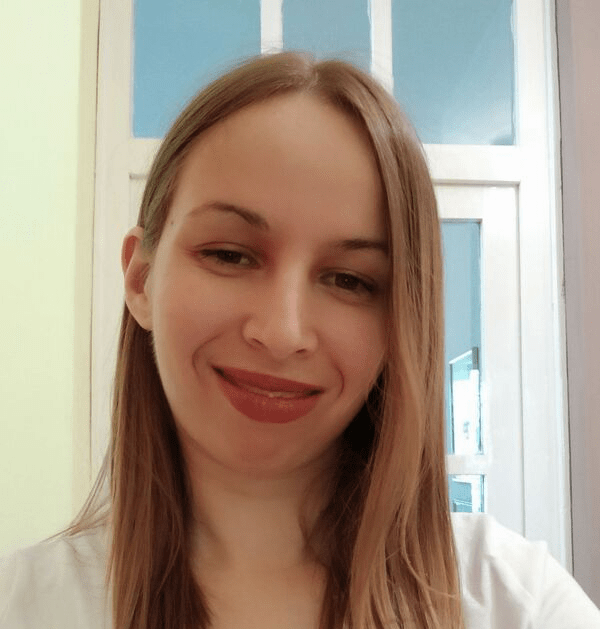As a project or operations manager, one concern you may have is how to make a work schedule that fairly distributes a team workload.
Sometimes it’s challenging to create and adjust schedules effectively to meet project needs while also keeping employee preferences in mind.
Still, it doesn’t have to be like that. To put your mind at ease and help you prepare effective schedules, we’ll share some actionable tips and templates in this blog post.

What’s a work schedule?
An employee work schedule shows when employees are scheduled to work and gives additional information about their shifts and work hours.
Also known as a rota or roster, a work schedule helps businesses:
- Operate more effectively,
- Monitor employee availability, and
- Avoid scheduling conflicts.
A typical office schedule contains information such as:
- Work hours,
- Shifts,
- Work locations,
- Responsibilities during the time period covered by the schedule, and
- Other associated employee information.
Creating an employee shift schedule for work is referred to as scheduling. Project, operations, or HR managers, such as yourself, are typically the ones responsible for creating schedules. In fact, here are some of the businesses that require schedules:
- Retail stores,
- Manufacturing facilities,
- Restaurants and coffee shops,
- Call centers,
- Businesses with customer/user support teams,
- Businesses that employ freelancers, and
- Businesses that employ seasonal workers.
Why is work scheduling important?
There are many benefits of creating an employee work schedule. To name a few, a proper work timetable:
- Ensures efficient operation — when employees understand their work hours,responsibilities, and their work location (in case they perform fieldwork), they’re in a position to maximize their productivity.
- Helps plan work according to employee availability — to ensure minimum changes along the way, operations managers should take into account employee attendance, their expected work hours, and time-off requests.
- Eradicates the idea of favoritism — when shifts are transparent, team members can see everyone’s shifts/tasks, which eliminates the risk of favoritism.
- Lets you better manage your time and meet deadlines — proper time management is important for maintaining high productivity, and a working schedule helps you organize your workload better, thus making you more productive.
- Promotes a healthy work-life balance — when employees are aware of when they’re scheduled to work, they can plan and balance their work and private life.
- Decreases employee turnover — having a practical work schedule is vital to maintaining employee satisfaction, and this, in turn, decreases your workers’ stress levels. Employees who have low stress levels and feel like they’re as appreciated as their colleagues are less likely to leave their jobs.
- Helps increase customer/client satisfaction — an organized office schedule is especially beneficial if your business requires you to communicate with customers — it can reduce average waiting time and increase your customers’ overall satisfaction.
What are the types of work schedules?
Although work schedules come in various shapes and sizes, we can still pick out 14 main types of work schedules.
1. A full-time schedule / 40-hour work schedule
A full-time employee work schedule requires employees to work between 35 and 40 hours per week. It’s usually tied to job positions where the amount and type of workload require full-time specialists.
Many US states mandate that employees working on full-time schedules receive employee benefits. Most such employees work the same number of days per week and hours per day.
However, their exact working hours may be:
- Fixed (e.g., 9 a.m. – 5 p.m.), or
- Flexible (e.g., 8 hours per day, in no fixed order).
Example: An in-house designer scheduled to work 40 hours per week, 8 hours per day, from Monday to Friday.
💡 CLOCKIFY PRO TIP
Need help creating an 8-hour workday schedule? Check out our article on this topic:
2. A part-time schedule
A part-time working schedule requires employees to work less than the full-time equivalent schedule prescribed by the company (e.g., in companies that count 35 hours per week as full-time, anything less counts as part-time).
A part-time schedule is usually tied to job positions where the type of workload permits several part-time employees to carry it out, or the workload doesn’t require full-time employment.
Employees with part-time office schedules may not get employee benefits usually associated with full-time work. Such schedules may be:
- Consistent (e.g., 9 a.m. – 2 p.m. every workday), or
- Not consistent (e.g., 8 a.m. – 1 p.m. from Mondays to Wednesdays + 1 p.m. – 6 p.m. on Saturdays and Sundays).
Example: A restaurant hostess who works 25 hours per week in total during the busy times of the day.
💡 CLOCKIFY PRO TIP
If you want to learn more about part-time and full-time employment, and see the differences between the two, check out our article on this topic:
3. A fixed schedule
A fixed employee work schedule has a timetable with the same number of working days and hours per week. It may be used for any business that requires employees to work together simultaneously or be available to serve customers/clients during fixed open hours.
A fixed schedule may involve full-time or part-time work.
Example: A team of HR specialists who are scheduled to work Monday through Friday from 9 a.m. to 5 p.m.
4. A flexible schedule
A flexible working schedule requires that an employee work a specific number of flex hours per day as a minimum requirement (e.g., 6 hours). But the actual hours will depend on the employee’s time of arrival at the workplace, for example:
- The employee arrives on Monday at 8 a.m. and then works until 2 p.m., but,
- They arrive at 9 a.m. on Tuesday and then work until 3 p.m.
Track work hours with Clockify
Such schedules may be full-time or part-time. They may be used for any type of business that doesn’t require employees to work together at the same time or be at service to customers/clients during fixed open hours.
Example: A customer support specialist is scheduled to work 8 hours per day, Monday through Friday, from the moment of arrival to the office.
5. A floating schedule
A floating employee shift schedule involves:
- A fixed main part (the employee is at the disposal of the employer), and
- A variable, or the “floating” part (the employee can choose their start and end times during the workday).
In practice, floating schedules have been in use for some time. In particular countries, like Belgium, there are laws that regulate floating schedules. For instance, according to the Belgian Social Criminal Code, it’s mandatory for employers to track all working hours when applying such schedules.
Example: A maintenance technician is scheduled to replace a vital part of an ice cream machine after every 20,000 gallons of ice cream are produced, which happens every 2 weeks. While the ice-cream machine maintenance is a fixed assignment that occurs every 2 weeks, the maintenance technician performs other work in the meantime.
6. A shift-based schedule
A shift-based schedule is usually implemented in businesses that operate for 10 or more hours per day. If a business operates 24/7, it typically implements a 3-shift approach — employees always work or take turns working:
- First shift (morning shift),
- Second shift (afternoon shift), and
- Third shift (night shift).
Example: 3 gas station attendants who take turns working in three 8-hour shifts (7 a.m.– 3 p.m., 3 p.m. – 11 p.m., and 11 p.m. – 7 a.m.) Monday through Thursday.
7. A seasonal schedule
A seasonal employee shift schedule is always limited to a specific season or time period (e.g., the winter holiday season in November and December).
This schedule can be:
- Shift-based,
- Flexible,
- Fixed,
- Part-time, or
- Full-time.
Example: 2 Santa Clauses scheduled to work in a shopping mall throughout November and December in 2 shifts (Shift 1: 8 a.m. – 2 p.m. and Shift 2: 2 p.m. – 8 p.m.).
💡 CLOCKIFY PRO TIP
Certain industries require varying amounts of work during specific seasons. For many, this is a great opportunity to get additional work. Learn more about seasonal work in our guide:
8. An overtime schedule
An overtime office schedule involves working more than the standard 40 hours per week.
Depending on the day or length of overtime, as well as the US state where the worker is employed, overtime is paid either 1.5 or double the regular employee rate. However, only employees not exempt from the Fair Labor Standards Act (FLSA) are entitled to overtime pay.
Example: A waiter scheduled to work 45 hours in one week — the 5 extra hours scheduled are considered overtime.
💡 CLOCKIFY PRO TIP
Do you need assistance with calculating overtime work hours? Our free overtime calculator can help you:
9. A compressed schedule
A compressed employee shift schedule involves working the traditional 35-40 hours per week, but in fewer days.
For instance, employees can be scheduled to work 4 days a week, 10 hours a day.
Example: A window washer scheduled to work 40 hours per week, 10 hours per day (7 a.m. – 5 p.m.) Monday through Thursday.
10. A rotating schedule
A rotating schedule is usually tied to shift-based work. Employees are assigned rotating shifts based on a predefined pattern, usually on a weekly or daily basis.
Example: A doctor working in the ER is scheduled to work 12-hour day shifts on Mondays and Saturdays and 12-hour night shifts on Tuesdays and Sundays. Wednesdays, Thursdays, and Fridays are off.
11. A split schedule
A split working schedule involves parsing a workday into 3 distinct points:
- Working for a few hours in one go,
- Having several hours off, and
- Working for another set of hours after the break.
Example: A taxi driver scheduled to work from 5 a.m. to 9 p.m. takes a break from 9 a.m. to 2 p.m. and then resumes work from 2 p.m. to 9 p.m.
12. An on-call schedule
An on-call work timetable involves employees being available during specific times of day, or days in general, when they may (or may not) be called in to work.
Example: A firefighter scheduled to work on-call must be within a 5-minute vicinity of the fire station on the scheduled days.
13. 9/80 work schedule
A 9/80 work schedule is a variation of a compressed schedule, as it includes 80 work hours spread over 9 days rather than the usual 10 days.
With this working schedule, employees have an extra day off every second week in addition to the weekend.
In the first week, employees work 9 hours on Monday through Thursday and 8 hours on Friday, totaling 44 work hours.
In the second week, they work 9 hours on Monday through Thursday and have a day off on Friday, totaling 36 hours. In total, that’s 44 work hours in the first week and 36 hours in the second week (44+36=80).
Employees can choose when to have a day off during the second week.
Example: Clif Bar is a company that offers this type of schedule. They believe that it fosters a healthy, stress-free work environment, allowing employees to do things they enjoy and spend time with their families.
14. 4/10 work schedule
A 4/10 work timetable means that employees work 10 hours per day for 4 working days.
Since a 4/10 work schedule is considered a compressed schedule, after finishing a 10-hour shift 4 days in a row, employees usually have an extra day off (on top of the traditional 2) they can use to recover and rest.
Example: The 4/10 work schedule can be used in many industries. For instance, a web developer can work for 10 hours a day, Monday through Thursday, and have a day off on Friday.
💡 CLOCKIFY PRO TIP
If you want to learn more about a 4-day work week, check out our article:
So, what is the best work schedule? There’s no right or wrong answer, because it all depends on your preferences.
No matter the schedule you choose for your business, keep in mind that you can customize it to your and your company’s needs. For example, if you don’t always have the same workload, consider employing both full-time and part-time workers to ensure proper task distribution.
How best to create work schedules?
Creating a proper employee work schedule requires careful preparation — at least if you want to avoid making additional changes and disrupting your team’s productivity.
That’s why we’ve carefully outlined each step you need to take to create a perfect work schedule for your team.
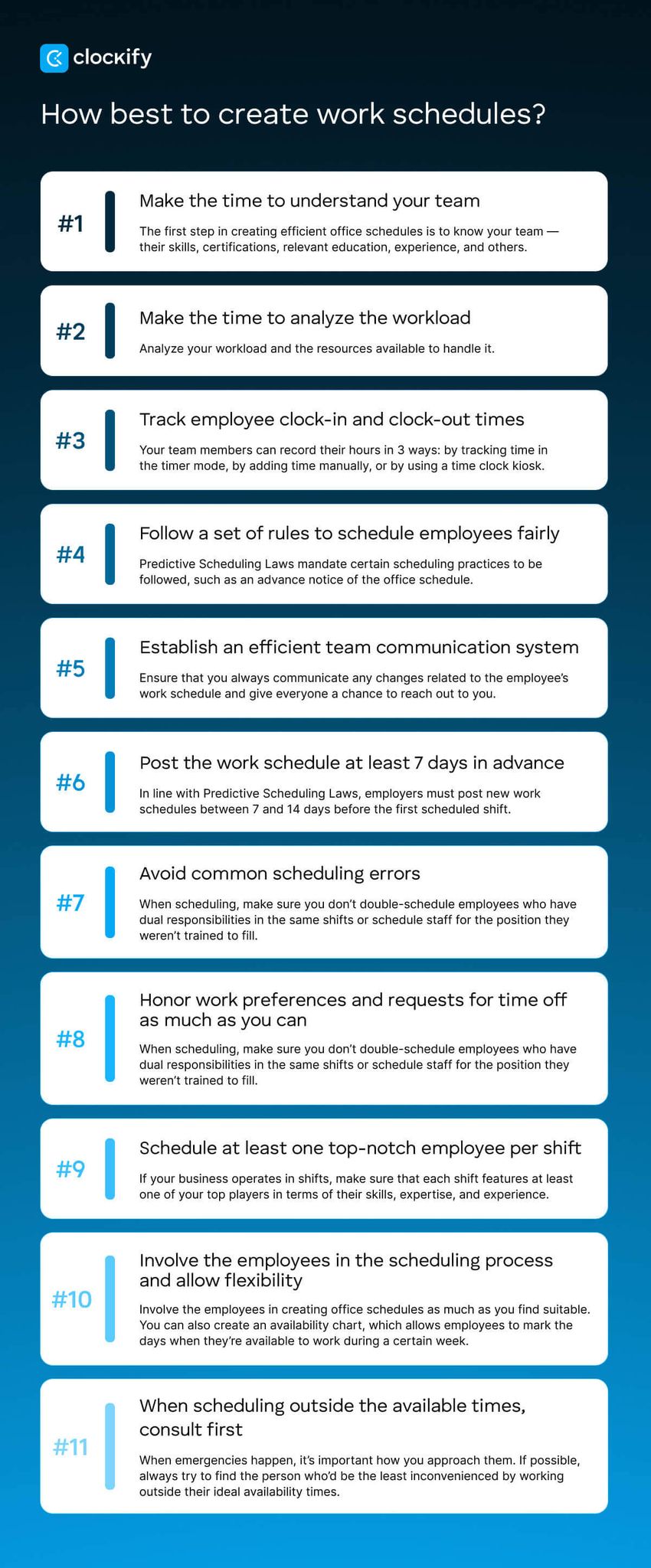
#1: Make the time to understand your team
The first step in creating efficient office schedules is to know your team. Make a list that includes their:
- Relevant skills,
- Personal qualities such as perseverance, efficiency, or reliability,
- Certifications, relevant education, experience,
- Their employment status (are they full-time or part-time?),
- Personality type (are they introverted or extroverted?), and
- Work habits, especially if you have flexible schedules, and some employees have the habit of arriving sooner than others.
With such a list, you’ll be able to pick the ideal teammates for each shift/task.
Example: Tasking the extroverted full-stack developer, who tends to come in later and finish work later, with the 5 p.m. daily call with a client who’s just starting their workday due to the time zone difference.
#2: Make the time to analyze the workload
The next step is to analyze your workload and the resources available to handle it.
For this purpose, you can use an employee time clock app to define your projects and assign tasks to each team member.
First, you’ll need to create projects for your team. For each project, you can set its estimated time and/or budget.
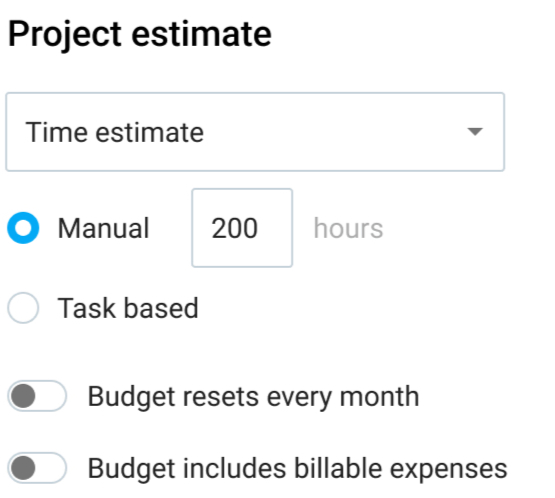
For instance, if you set a time estimate of 200 hours for a project, you’ll need to organize and delegate tasks that will last up to 200 hours. If you have 10 team members, this means you can delegate 20 hours of the project to each team member.
#3: Track employee clock-in and clock-out times
Once all the tasks are distributed, your team members can record their hours in 3 ways:
- By tracking time in the timer mode,
- By adding time manually, or
- By using a time clock kiosk.
If you opt for a time kiosk, your employees can log in using their PIN code on a shared device at the beginning of their shift and clock out at the end.

Moreover, the time kiosk also allows you to see statuses such as:
- Employees currently working,
- Employees using a break, and
- Employees who have finished their shifts.
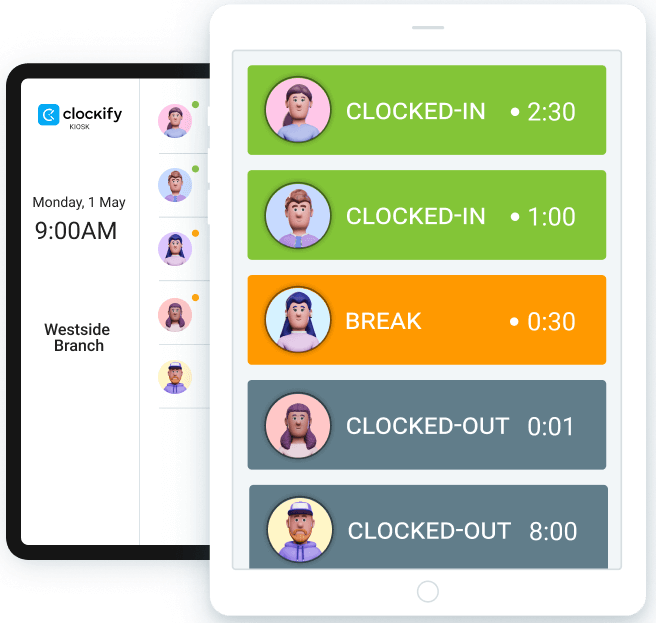
All the time entered can later be viewed in weekly reports that can assist you in creating even better schedules in the future.
If your employees log billable hours, you can also use Clockify data for payroll — since the tracker will automatically calculate how much you need to pay employees based on their tracked time.
💡 CLOCKIFY PRO TIP
To learn more about how best to set up and carry out a clock-in clock-out system, check out our detailed blog post about it:
#4: Follow a set of rules to schedule employees fairly
Although there’s still much to be done to ensure employees can maintain a healthy work-life balance, Predictive Scheduling Laws are one step further in protecting employees from overworking.
These laws mandate certain scheduling practices to be followed, such as an advance notice of the office schedule.
In case the employee wasn’t timely notified about their upcoming schedule, they receive a guaranteed predictability payment.
In the US, only Oregon has enacted this law statewide, while states like California and New York have enacted Predictive Scheduling Laws in particular cities.
If you need help creating your scheduling policy, you can follow the 10 scheduling rules prescribed by these laws.
#5: Establish an efficient team communication system
Do you shudder just thinking about shift swapping and last-minute schedule changes? Handling changes in schedules can be overwhelming for most project managers.
To manage scheduling effectively, you’ll need to establish a well-organized communication system, which can involve business messaging apps.
Ensure that you always communicate any changes related to the employee’s work schedule and give everyone a chance to reach out to you.
To establish an efficient communication system, don’t forget to:
- Notify the employees as soon as you’ve finished and posted the newest work schedule,
- Let everyone know about last-minute schedule updates or unexpected additional obligations, and
- State that your team needs to inform you whenever they swap shifts or take up additional tasks, since these changes could influence further scheduling.
#6: Post the work schedule at least 7 days in advance
In line with Predictive Scheduling Laws, employers must post new work schedules between 7 and 14 days before the first scheduled shift. However, apart from Oregon, these laws are mainly enacted in certain cities because they fall under local ordinances.
Federal employment laws, such as the Fair Labor Standards Act, allow employers to change schedules without prior notice.
Still, when you inform your team members about their schedules days in advance, you should leave enough time in case someone:
- Needs to schedule (or reschedule) personal commitments to accommodate the new work schedule,
- Wants to find a substitute or trade shifts (you can either let employees trade shifts or have a system for substitutes), and
- Wants to discuss the days and times they work (perhaps you’re always scheduling employee X on times and days that never work for them).
If you’re using Clockify for scheduling, you can easily notify team members about their work hours and any potential changes in the work schedule.
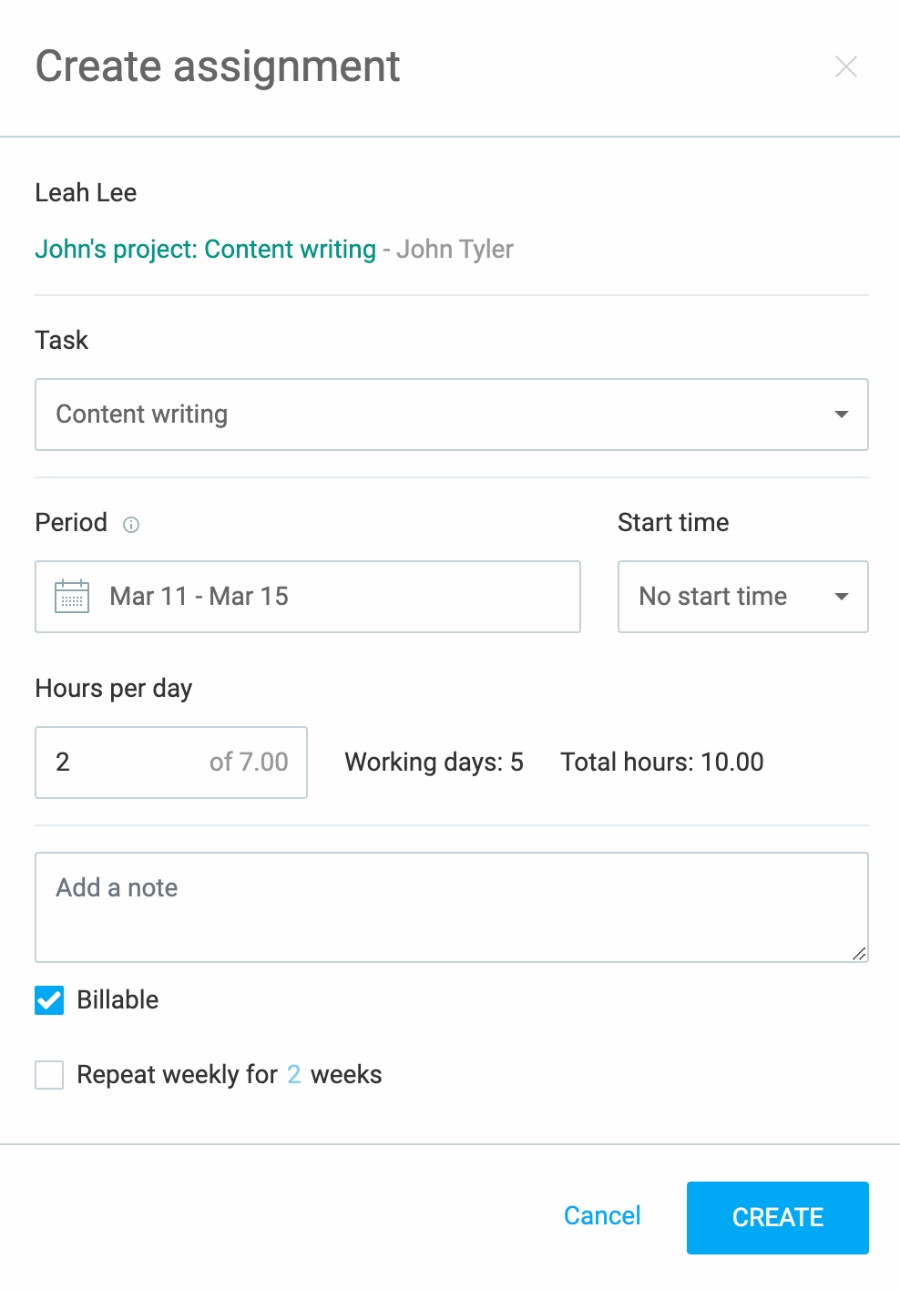
Posting an employee work schedule in advance reduces the likelihood of employees being unaware of their shifts and assignments.
#7: Avoid common scheduling errors
When scheduling, make sure you don’t:
- Double-schedule employees who have dual responsibilities in the same shifts — sometimes, your employees may have several responsibilities, so it’s necessary to avoid double-scheduling their shifts. This is quite common in the hospitality industry, where a person who works as both the hotel hostess and a busser may accidentally get double-scheduled.
- Schedule staff for the position they weren’t trained to fill — regardless of how large or small a business you own, there’s always the risk of scheduling some of your staff to fill in the duties they aren’t trained to complete. You could, for example, schedule a customer success agent to perform the duties of the customer support agent — so make sure to double-check everything before making the employee work schedule public.
- Under-schedule or over-schedule your employees, in terms of their work hours — if you employ both part-time and full-time employees, you’ll need to be extra careful not to schedule anyone with too many or too few shifts. The same goes for the expected workload — keep your workload in mind when choosing the number of employees for specific shifts.
💡 CLOCKIFY PRO TIP
Overworking often brings more harm than good, but it can sometimes go unnoticed. Find out why recognizing this issue should be your top priority:
#8: Honor work preferences and requests for time off as much as you can
If certain employees prefer to work on certain hours or days, accommodate them if possible.
Or, when an employee asks for time off, try to agree to their request whenever possible.
Moreover, you should always implement a clear system for employees asking for preferred schedules and time off. This way, you’ll make the request approvals/denials transparent, making it clear there’s no favoritism.
If you and your team are using Clockify to track work hours and plan tasks in advance, you can set a time off policy and approve your team’s time off requests on the spot.
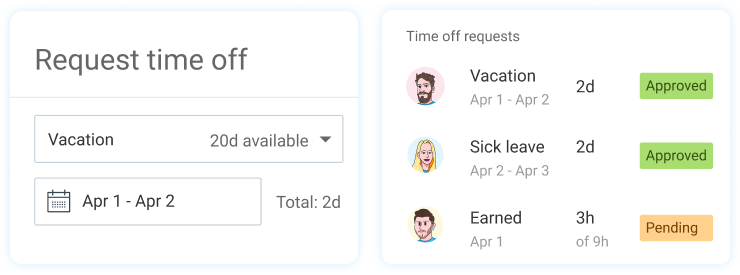
Using Clockify as a time-off and vacation tracker also provides you with accurate insights into everyone’s availability and upcoming leaves, allowing you to schedule their work time accordingly.
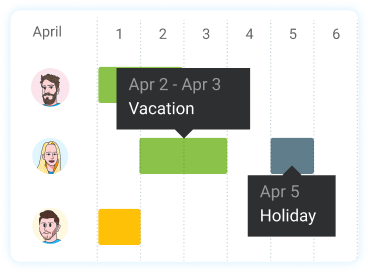
💡 CLOCKIFY PRO TIP
There’s no need to overwhelm yourself with crafting a perfect PTO policy when you can just introduce one by picking among our 11 free PTO policy templates:
#9: Schedule at least one top-notch employee per shift
If your business operates in shifts, make sure that each shift features at least one of your top players in terms of:
- Employee skills,
- Expertise,
- Experience, and
- Personal qualities.
This will vastly improve the shift’s quality and customer experience. Moreover, the less-experienced employees (especially the newly hired ones) will have someone to look up to in terms of work standards or turn to for support when needed.
Having one of your best employees is especially relevant during busy times when you want someone reliable at the scene to “pull” the workload and inspire other teammates to keep up the pace.
Example: Scheduling a reliable food service specialist to operate the cash register, serve customers, and stock supplies during lunchtime in a city’s business district.
#10: Involve the employees in the scheduling process and allow flexibility
If you’re wondering how to build a fair work schedule, the answer may be flexibility. In other words, involve the employees in creating office schedules as much as you find suitable.
CEO of a payroll service company, Guillermo Triana, says his best tip is to build your first draft with gaps:
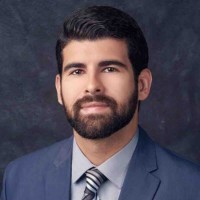
“Leave 15% of the schedule blank and have employees pitch for those shifts in order of priority. If someone’s personal life changes and they need 2 weeks off evenings, they shouldn’t have to beg, but simply plug into a system that already allows for that flexibility.”
Another expert we contacted, Wynter Johnson, founder and CEO of a marketing consultancy firm, agrees and adds that there’s no such thing as too much employee input:

“I’ve only ever gotten into trouble with scheduling when I wasn’t listening to my employees.”
In line with this tip, you can also create an availability chart. With an availability chart, all employees need to do is mark the days when they’re available to work during a certain week. Later on, you’ll use this data to create feasible shift rosters.
#11: When scheduling outside the available times, consult first
Sometimes, despite all the efforts the team has made with the availability chart, you’ll still need to schedule someone outside their availability times.
Emergencies happen, but it’s important how you approach them. If possible, always try to find the person who’d be the least inconvenienced by working outside their ideal availability times.
It would be best to contact the person in question, explain the situation, and make the request politely. A reliable, conscientious employee will oblige your request if possible and appreciate a say in this.
Still, try to be understanding if an employee is genuinely unable to agree to your request, such as due to a doctor’s appointment.
Use work schedule templates to speed up the scheduling process
If you’re a project or operations manager, and you’d like to avoid administrative inefficiencies and manual work, you can turn to team schedule templates.
The following employee work schedule templates will help you make the scheduling process faster and more accurate — and you can use them for free.
If you’re downloading the Google Sheets template, simply click the download link and then select “Make a copy” when the new window opens. For PDF templates, simply click on the download link, and a copy will be automatically downloaded to your device.
Employee Availability Form Template
The Employee Availability Form Template allows your team to share their available hours with you — so that you can schedule their work time accordingly.
How to use the Employee Availability Form Template?
The employees should mark:
- The time they can come to work, and/or
- The time they can be on-call duty with checkmarks in Google Sheets.
Alternatively, you can print the forms and have the employees fill them out with a pen.
Later, you can use these work timetables to create shift schedules.
Who is the Employee Availability Form Template for?
This scheduling form is ideal for any business that relies on scheduling.

⬇️ Download the online, shareable Employee Availability Form Template in Google Sheets
⬇️ Download the printable Employee Availability Form Template in PDF
Daily Work Schedule Template
The Daily Work Schedule Template lets you schedule both work hours and tasks for each workday.
How to use the Daily Work Schedule Template?
Simply insert:
- The employee’s name,
- Their department,
- The date, and
- A checkmark (Google Sheets) next to each hour they’re scheduled to work.
Alternatively, you can print the PDF version of our daily schedule and fill it out with a pen.
Who is the Daily Work Schedule Template for?
This template is perfect if you prefer to schedule work hours and tasks daily.
If you need to stay compliant with the rule of scheduling work at least 7 days in advance, you can combine this more detailed, task-oriented schedule with schedules that cover a longer time period.

⬇️ Download the online, shareable Daily Work Schedule Template in Google Sheets
⬇️ Download the printable Daily Work Schedule Template in PDF
Weekly Work Schedule Template
The Weekly Work Schedule Template allows you to schedule employees’ workdays and shifts on a weekly basis.
How to use the Weekly Work Schedule Template?
Simply add the employee names and an “X” under each day they’re scheduled to work (“Type X if scheduled to work” row).
Then, add the type of shift — first, second, third, or split shift roster.
The Google Sheets version of our weekly schedule template also calculates the daily statistics per employee in terms of:
- How many times individual employees have been scheduled to work per week, and
- How many times they were scheduled to work the First, Second, Third, or Split shift (if applicable).
Alternatively, you can print the schedule and fill it out with a pen.
In case your employees work different split shifts, work overtime, or have specific requests regarding their schedules, you can clarify this below each employee row.
Who is the Weekly Work Schedule Template for?
The weekly schedule template is perfect if you prefer to schedule work days weekly, and/or pay your employees every week.
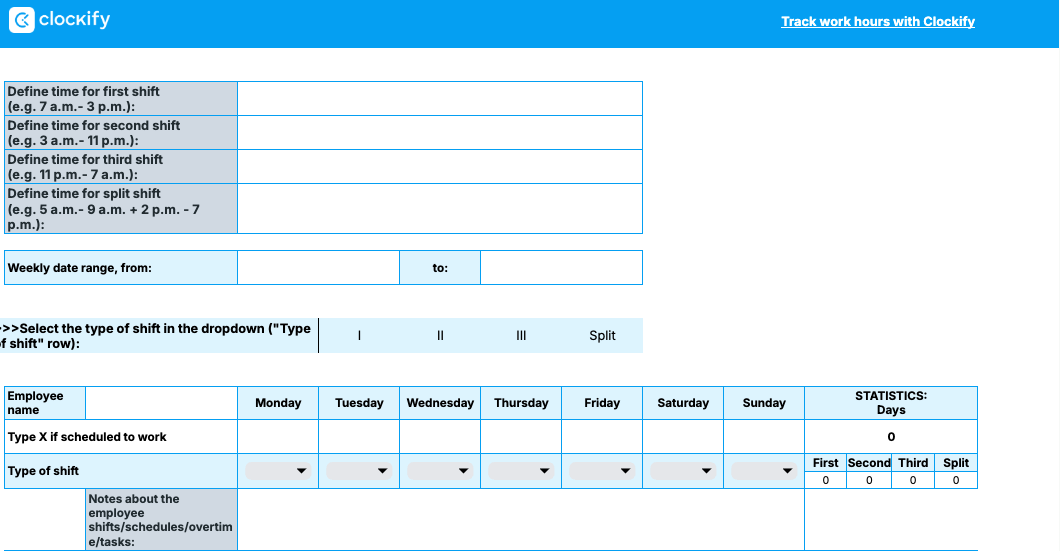
⬇️ Download the online, shareable Weekly Work Schedule Template in Google Sheets
⬇️ Download the printable Weekly Work Schedule Template in PDF
Bi-Weekly Work Schedule Template
The Bi-Weekly Work Schedule Template gives you the option to schedule both the employees’ work days and shifts on a bi-weekly basis.
How to use the Bi-Weekly Work Schedule Template?
Simply add the employees’ names and add an “X” for each day they’re scheduled to work.
The Google Sheets version of the template also calculates the daily statistics per employee in terms of:
- How many times individual employees have been scheduled to work every two weeks, and
- How many times they were scheduled to work the First, Second, Third, or Split shift (if applicable).
Alternatively, you can print the schedule and fill it out with a pen.
In case your employees work different split shifts, work overtime, or have specific requests regarding their schedules, you can clarify this below each employee row.
Who is the Bi-Weekly Work Schedule Template for?
This template is perfect if you prefer to schedule workdays on a bi-weekly basis, and/or pay your employees bi-weekly.

⬇️ Download the online, shareable Bi-Weekly Work Schedule Template in Google Sheets
⬇️ Download the printable Bi-Weekly Work Schedule Template in PDF
💡 CLOCKIFY PRO TIP
What’s exactly the difference between bi-weekly and monthly payroll? Find out from our blog:
Monthly Work Schedule Template
The Monthly Work Schedule Template allows you to schedule employees’ workdays and shifts for each date on a monthly basis.
How to use the Monthly Work Schedule Template?
Simply add the employee names, and an “X” under each date they’re scheduled to work.
The Google Sheets version of the template also calculates the daily statistics per employee in terms of:
- How many times individual employees have been scheduled to work per month, and
- How many times they were scheduled to work the First, Second, Third, or Split shift (if applicable).
Alternatively, you can print the schedule and fill it out with a pen.
In case your employees work different split shifts, work overtime, or have specific instructions regarding their schedules, you can clarify this below each employee row.
Who is the Monthly Work Schedule Template for?
This shift roster template is perfect if you prefer to schedule workdays on a monthly basis, and/or pay your employees every month.

⬇️ Download the online, shareable Monthly Work Schedule Template in Google Sheets
⬇️ Download the printable Monthly Work Schedule Template in PDF
Yearly Work Schedule Template
The Yearly Work Schedule Template lets you schedule 5 employees over the course of one year (or several weeks or months).
How to use the Yearly Work Schedule Template?
Simply name your employees and associate each with a symbol (“X1”, “X2”, “X3”, “X4”, and “X5”).
Write the appropriate symbol (e.g., “X1” for employee 1) next to the suitable date to schedule an employee.
Who is the Yearly Work Schedule Template for?
This schedule maker template is perfect if your team operates on a rotating schedule or you manage seasonal workers. It can also be a great choice if you prefer to view and plan the workweeks on a larger scale.
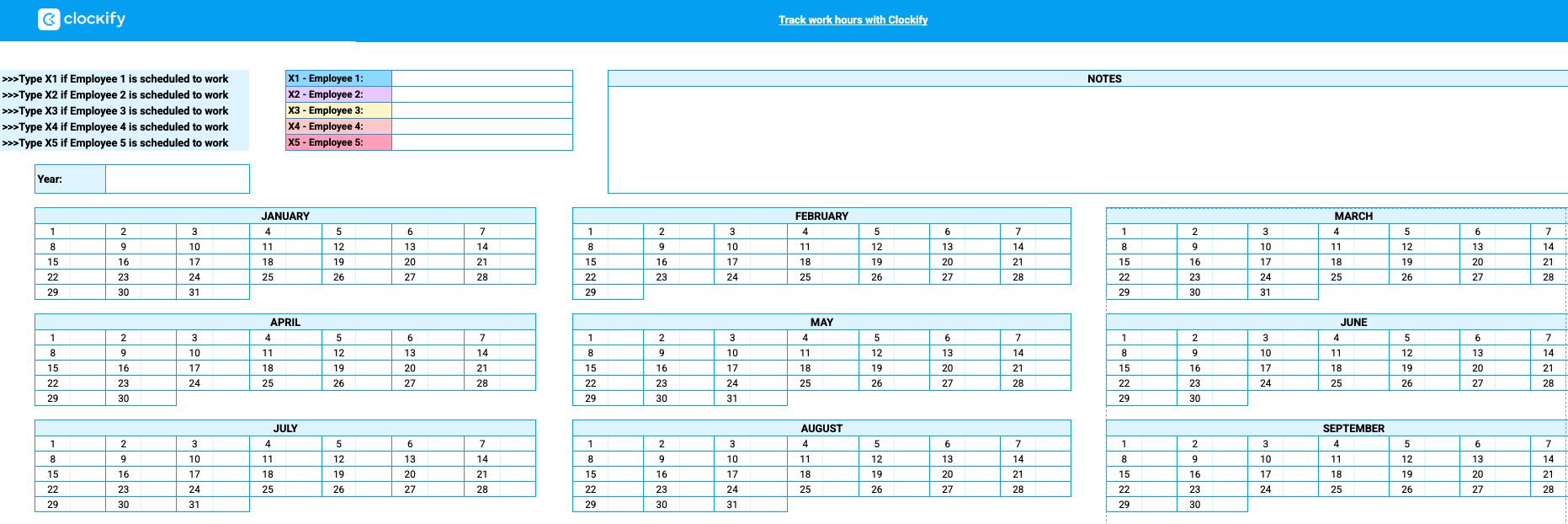
⬇️ Download the online, shareable Yearly Work Schedule Template in Google Sheets
⬇️ Download the printable Yearly Work Schedule Template in PDF
Create a perfect work schedule with Clockify
Making employee schedules shouldn’t be a challenge — if you follow through with all the steps we’ve listed above. Yet, since you’ll need to invest quite some time into devising a fully-functional work schedule, having a dedicated tool can help you skip a few steps along the way.
This is where Clockify’s project and team scheduling feature comes in.
With this feature, you can:
- Create shift schedule,
- Monitor your teams’ availability, and
- Have an overview of team capacity.
More precisely, you can either look at separate projects and see who’s actively involved in them, or check up on individual team members and quickly figure out:
- Who’s available,
- Who has open slots in their calendars, and
- Who’s working over capacity.
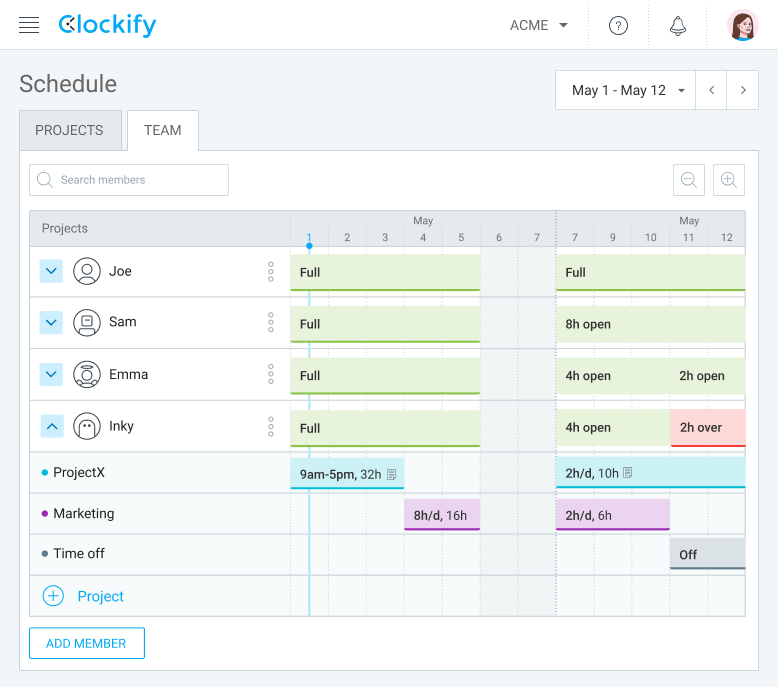
And if you need any help along the way, Clockify offers full human customer support, available 24/7 — free of charge.


